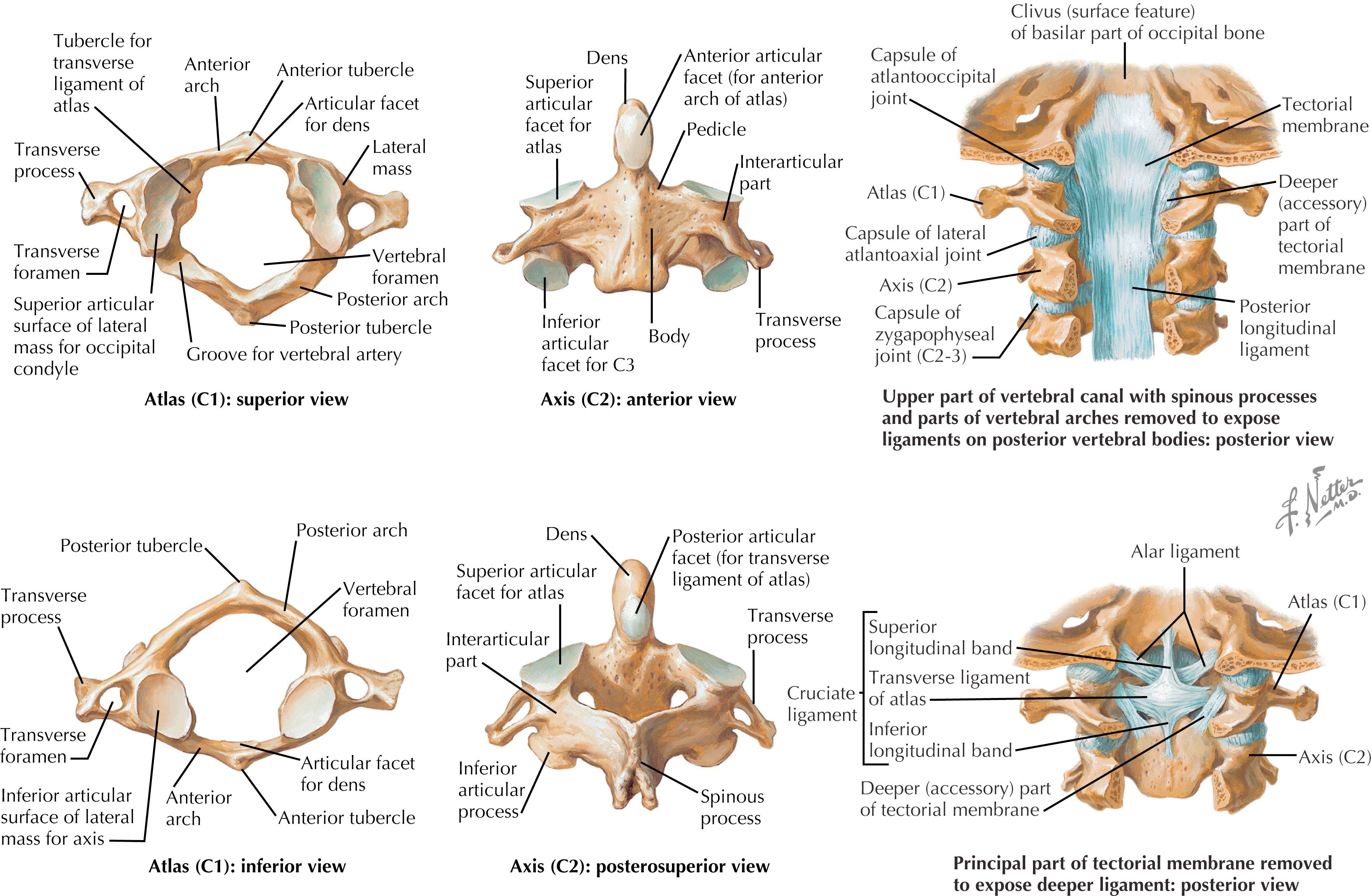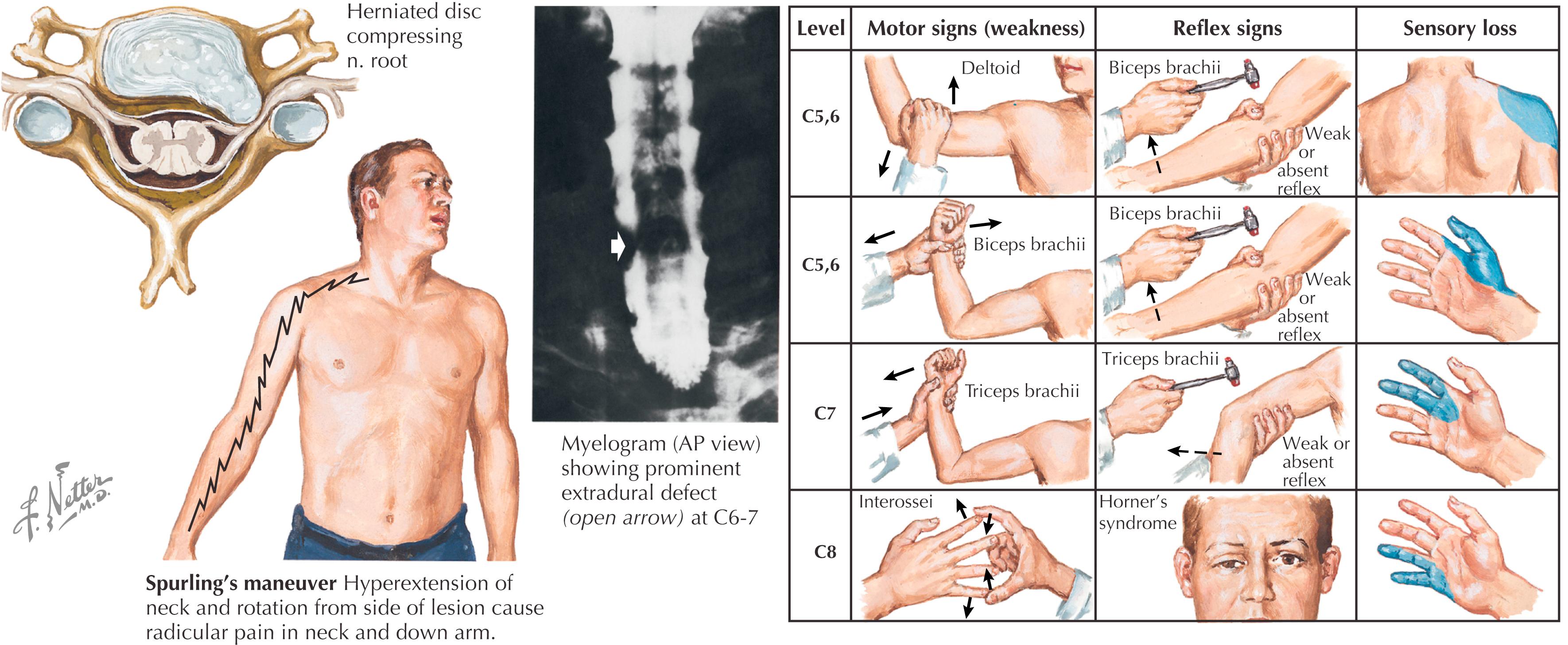Physical Address
304 North Cardinal St.
Dorchester Center, MA 02124
Cervical spine injuries are most often seen in football and hockey but have occurred in wrestling, rugby, baseball, lacrosse, skiing, snowboarding, equestrian sports, and mountain biking.
There are seven cervical vertebrae and eight cervical nerves.
Spinal nerves exit above the vertebral body for which they are named; for example, the sixth cervical nerve exits at the C5–C6 disc space.
The cervical spine is divided into upper and lower segments. The upper segment includes C1 (the atlas) and C2 (the axis). The spinal cord occupies a little space because the canal is funnel shaped in the sagittal plane. The atlas (C1) and the occiput account for 40% of cervical flexion. Together they account for 5–10 degrees of lateral bending. The axis (C2) has a finger-like projection, the dens, about which the atlas rotates; this accounts for 60% of cervical rotation. The key for C1 and C2 stability is the transverse atlantal ligament, which lies posterior to the body of C2 and connects C1 to C2. Distraction of this ligament can cause atlantoaxial instability ( Fig. 46.1 ).

The lower segment of the cervical spine includes C3–T1. The bony structure is relatively constant, with anterior column support provided by the anterior longitudinal ligament, the vertebral bodies, and the discs. Posterior column support is provided by the posterior longitudinal ligament, facet articulation, facet capsule, interspinous ligament, and supraspinous ligament. The spinal cord occupies 75% of the canal at this level. Clinically, the space available for the spinal cord (SAC) ranges between 13 and 23 mm. The cord is stenotic when the available space is <13 mm. Cord compression may occur when the space is less than 10 mm. The Torg ratio is calculated by taking the space available for the cord and dividing it by the anterior-to-posterior dimension of the vertebral body. Stenosis is indicated by a ratio less than 0.8 and increased risk for neurologic injury.
First, the physician should enquire if and where the athlete has symptoms. Does the athlete have full movement and sensation of the extremities? The physician should enquire about neck pain and does the athlete remember the injury.
The physician should then ask about the injury, including the direction of the athlete’s helmet at the time of injury and the radiation of symptoms and their resolution.
The athlete must be removed from the field in a safe and protected manner. Six people who have practiced the maneuver before injury must logroll the athlete onto a spine board and safely transport the athlete to the sidelines. The helmet should not be removed, but the airway must be protected and maintained. The physician and trainers should be familiar with the removal of all types of face masks. A power screwdriver is essential to accelerate face mask removal. This is appropriate for football and hockey.
A patient with pain must be examined with palpation. A step-off may indicate instability.
A fracture of the cervical spine may present with minimal pain, and the physician and the medical staff should be aware of this fact. Unstable fractures may present as radicular pain.
Athletes who are suspected to have cervical spine injuries should be immobilized.
If only radicular symptoms are present, the athlete should be examined for range of motion of the cervical spine, followed by a neurologic evaluation.
Although this examination is not a complete and thorough workup, it should be performed at a later date.
Strength is tested by comparing both sides at a scale of 0–5 (5/5 indicates full strength). The deltoids are checked with the corresponding C5 nerve root. The biceps correspond to C6 and the triceps correspond to C7.
Sensation is checked with the thumb dorsally placed corresponding to C6, the long finger corresponding to C7, and the little finger corresponding to C8.
Reflexes are then checked with the biceps reflex corresponding at the elbow to C6 and the triceps to C7.
Spurling test may be performed if fractures have been ruled out, with the athlete’s head being rotated and extended toward the affected extremity ( Fig. 46.2 ).

A positive Spurling sign is elicited when pain is exacerbated with this maneuver and is often caused by impingement of a nerve root with a disc herniation or osteophyte.
Become a Clinical Tree membership for Full access and enjoy Unlimited articles
If you are a member. Log in here